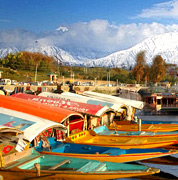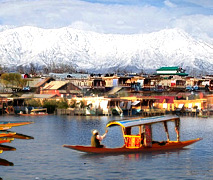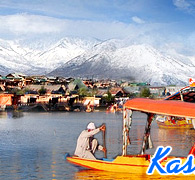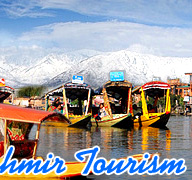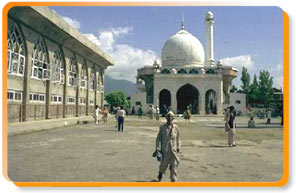 Jammu & Kashmir has a good share of Indian
historical and archaeological legacy. There has been a very unique and
glorious tradition of the people of the State of preaching and
worshipping of each other's religions and pilgrimage centres. There are
well-renowned Hindu shrines co-existing with the equally famous Muslim
pilgrimage centres that are held in highest esteem by the people of
every faith. Buddhism, which is still followed in the Ladakh region of
the State, has its origin in the valley and was preached and
disseminated by the Kashmiri scholars in its earlier days. There are
some wonderful examples of this communal harmony in pilgrimage centres
like the one at Hari Parbat where monuments of all three religions - a
temple, mosque and gurudwara are standing side by side. Some of the
important shrines and monuments of the region have been covered below:
Jammu & Kashmir has a good share of Indian
historical and archaeological legacy. There has been a very unique and
glorious tradition of the people of the State of preaching and
worshipping of each other's religions and pilgrimage centres. There are
well-renowned Hindu shrines co-existing with the equally famous Muslim
pilgrimage centres that are held in highest esteem by the people of
every faith. Buddhism, which is still followed in the Ladakh region of
the State, has its origin in the valley and was preached and
disseminated by the Kashmiri scholars in its earlier days. There are
some wonderful examples of this communal harmony in pilgrimage centres
like the one at Hari Parbat where monuments of all three religions - a
temple, mosque and gurudwara are standing side by side. Some of the
important shrines and monuments of the region have been covered below:Hazratbal Mosque
Situated in a village on the western shores of the Dal Lake opposite Nishat Bagh, it is a pristine white marble edifice casting its reflection in the waters of the lake. It is revered for the fact that it houses a hair of the prophet Muhammad, which is displayed to the public on religious occasions. Fairs are held on such occasions. People throng to the place every Friday to offer their prayers. Unlike the other mosques in Srinagar, which have a pagoda like roof, Hazratbal is the only mosque to have a domed roof. mosque in Srinagar; the others having distinct pagoda like roofs.
Jami Masjid
Situated in the heart of the old city of Srinagar, this huge mosque is visited by thousands of people who congregate here for the Friday prayers. The largest mosque in Kashmir, it is built around a courtyard with 370 wooden pillars to support it. Originally built by Sultan Sikandar in 1400, and enlarged by his son, Zain-ul- Abidin, it is a typical example of Indo-Saracenic architecture. Destroyed thrice by fire in 1479, 1620 and 1674 respectively and rebuilt each time, the mosque of today was repaired during the reign of Maharaja Pratap Singh. The principal features of the mosque are the four minars and eight wooden columns as support
Shankaracharya Temple
Believed to have been built at the auspicious site of Takht-e-Sulaiman, the sacred temple of Shankaracharya occupies the top of the hills in the southeast of Srinagar. Dating back to 250 BC, it is believed that it was the place where the great philosopher and saint Shankaracharya stayed when he visited Kashmir ten centuries ago to revive Sanatan Dharma. It was then that this place came to be known by his name instead of its former name Gopadri, an earlier edifice built on the same site by king Lalitaditya in the 6th century AD. Built on a high octagonal plinth and approached by a flight of steps, it has sidewalls that once bore inscriptions and the main surviving shrine consists of a circular cell. A modern ceiling covers the inner sanctum and an inscription in Persian traces its origin to the reign of Emperor Shah Jehan. The original ceiling was dome- shaped and the brick roof is not more than a century old.
Khanqah of Shah Hamadan
Situated on the banks of the River Jhelum, it is the first mosque ever built in Srinagar. The Shah Hamadan whose full name was Mir Sayed Ali Hamadni built the original mosque in 1395. Shah-i-Hamdan came from Persia in the 13th century and was responsible for the spread of Islam in Kashmir. Khanqah-i-Mualla was the place where he used to offer prayers. The Khanqah is a wooden structure whose chief aesthetic feature is its beautifully carved eaves and hanging bells. The interiors are richly carved and painted, and the antique chandeliers give it an air of magnificence.
Hari Parbat Fort & Temple of Sharika Devi
Built in the 18th century, atop the Sharika Hill, Atta Mohammed Khan constructed the fort from 1776 though the surrounding wall was built by Akbar in the 16th century and is much older. It has two gates, the Kathi and Sangin Darwaza. The Kathi is the main entrance with Persian commemorative inscriptions surrounding it while the Sangin is more ornate with sculptured windows on either side. Mow used as an arsenal, the fort contains a temple revered for its image of the Goddess Sharika, a form of Durga.
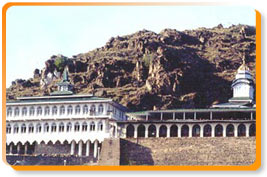 Makhdoom
Sahib
Makhdoom
SahibThe shrine, situated to the south of Hari Parbat, is dedicated to Makhdoom Sahib or Hazrat Sultan and is revered by Muslims and Hindus alike.
Chhatti Padshahi Gurudwara
Situated just outside the southern gate of Hari Parbat fort, Chatti Padshahi is one of the most important Sikh Gurudwaras in Kashmir. It is dedicated to the sixth guru of Sikhism who stopped here to preach occasionally while he was traveling through Kashmir.
Martand
The most memorable and beautiful work of Emperor Lalitaditya of Surya (meaning 'solar') dynasty is the construction of spacious Martand temple dedicated to the Sun god, Bhaskar. The style of the construction of the temple and the skill of the makers are rare in the history of the world. Now, in ruins, it is still appreciable for its design, beauty and art. Martand temple is a mirror of the art and skill of Kashmiri Hindus. In its backdrop are the snow-capped mountains and it is built with strong and square limestone. Its pillars have a Greek pattern that lends gorgeousness to this edifice.
Kheer Bhawani
Situated at Tullamulla in the Srinagar district, this spring is the most sacred place for Hindus in Kashmir. Hindus must abstain from meat on the days when they visit Kheer Bhavani or the milk goddess and offer her sugar, milk, rice and flowers. An annual festival is held here in May or June when a number of devotees visit the place to offer prayers and seek the blessings of the deity. The beautiful spring of clear water overshadowed by splendid shady trees and full of sacred fish adds an ethereal beauty to the place.
Awantipur
29 km from Srinagar, the famous Awantipur temples are believed to have been built in honor of God Mahadev by Awanti Varman. The temples, although in ruins, are of great archaeological interest. King Avantivarman founded the city in the 9th century. There are two main temples, one of which is Shiva-Avantishvara, which is larger and marked by massive walls some half a mile beneath the town on the outskirts of village Jaubror. Reduced to ruins now, the place almost lost its previous grandeur. and has been reduced to ruins, though it is still visited by the devout. The sculptured reliefs principally found on the walls of the entrance and the flank walls of the stairs depict men and women in the acts of drinking, lovemaking and other such merriments. The base is either a plain square block with the upper edge rounded off or is elaborately molded. Half a mile up is Avantisvami-Vishnu, a better-preserved temple.




